This blog-post is dedicated to my colleagues/friends at Natixis with whom we shared a grueling 21 hours and 6 minutes in the trails of Hong Kong over a distance of 100km and over 4700 meters of climb.
I would like to express my deep gratitude towards all the people at Natixis Asia who helped us in our fundraising with their generous contributions to Oxfam
“Coming together is a beginning, staying together is progress, and working together is success.” – Henry Ford
Olive et Tom
Back in my days at school, among all the classes we had, sport had always been the worst for me. I was the best student in all the classes but whenever physical activity came into play, I sucked at it. Sports could be divided into two categories, team sports and individual sports. Most of the disciplines that were taught at school were team-oriented, or should I say ball-oriented (basketball, football etc). Our instructors kept telling us that the key to any team sport is – you guessed it – teamwork “Jeu d’équipe”. I had no clue about what it meant, I actually didn’t care. I would always try my best to avoid having a ball in my sight, always trying to avoid it like a dizzy. The only teamwork concept that spoke to me was when I was watching “Olive et Tom”, a Japanese anime popular in France about a soccer player and his team called the “Newteam”
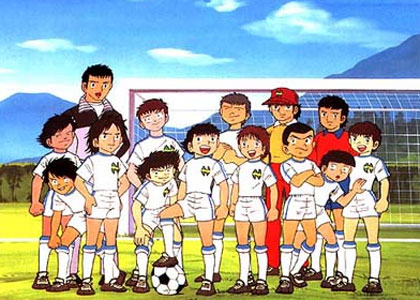
Although individual sports could take many forms (track and field, martial arts, racket sports..) the only one I was exposed to was… running, not the sprints/fun type but the endurance/boring type of running. I sucked at it even more. Had I know the concept of combining running and teamwork when I was a kid, I would have most likely dropped out of school just to avoid it.
Fast forward to mid-May 2018, among the hundreds of emails I receive daily, one was sent by Guillaume, the head of IT Asia Pacific – I never receive anything from him. It was about a corporate sport event. I don’t often receive anything about sports event. The subject was the Oxfam trail-walker in Hong Kong. The concept: walking/running across 100km of trails and mountains and 4700m of climb in teams of 4. The rule was simple: start, cross the 9 checking points and the finish line all together. The combination of teamwork and running. That got my full attention. The email was a call to find potential runners interested in joining the event. I saw this as an opportunity to make a redemption with team sports and why not being part of a “Newteam” too. After a few days of hesitation, I called Guillaume over the phone, he sounded very enthusiastic, I could tell he had great ambitions. Not long after I hanged up, I told him I was in. And just like that I suddenly was part of something that was going to be beyond a simple running event. The race was scheduled for November 16th.
Strava
Very quickly, the Natixis Oxfam Trailwalker team was formed. 11 people raised their hands, we then decided to form 2 teams, 8 running with a bib number and 3 running on the side or in case one would get injured during the training. We were 2 from Tokyo ( Miyuki and I) , 2 from Singapore ( Sebastien, Sallé) and 7 from Hong Kong ( Guillaume, Benjamin, Clement, Emile, Charles, Ly Tign, Walid) 9 males, 2 females, from mid 20s to mid 40 of age, all from different departments and different running levels.
Guillaume and Sebastien took the lead in the organization of the race. We would gather weekly on a video call to talk about logistics, training and fundraising topics. A Strava group was created in which the top 3 runners in weekly distance, climb and running time would be displayed on a podium. As I normally run between 100km and 160km per week I would easily take first place on the weekly distance for most of the times by a good margin and Sebastien would take second place most of the time. For the two other categories, I was clearly behind. I almost never made it on the climbing distance podium as it was often either Guillaume or Benjamin that would compete for the first place with very impressive vertical distances on a regular basis between 3000m and 5000m ( I barely reached 1000m each week).
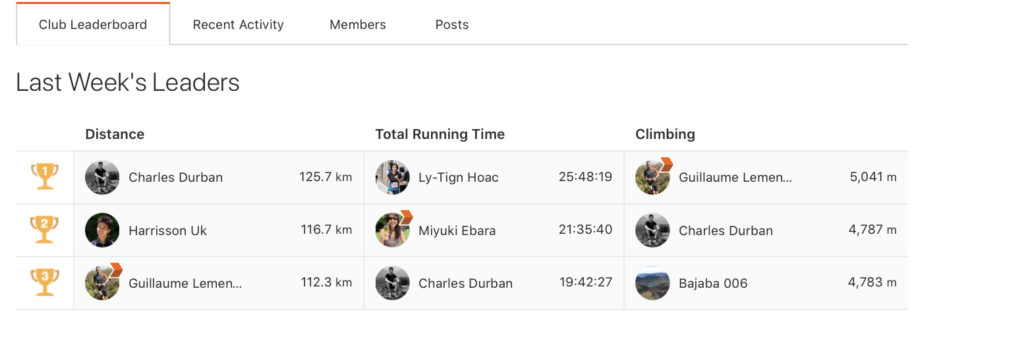
Apart from using the stats as a tool to show off in front of colleagues ( and chicks), the main purpose was to compose the two teams. During a video call, 4 weeks from the event, we made a roundtable to decide who was going to make the team 1 aka “Natixis Beyond Running” and team 2 aka “Natixis Beyond Walking”, unofficially the faster and slower team respectively.
When asked one by one, Miyuki and Ly Tign were volunteer to go to team 2. Sebastien and I, based on Strava’s statistics, were put in team 1. The rest of the team members wanted to be in the faster team but there were only 2 spots left. We decided to use the average weekly distance over the past 12 weeks to make the decision. After a somewhat delicate discussion, Guillaume and Benjamin were going to be in team one. So we had the two runners that ran the furthest and the two runners the climbed the highest. Emile didn’t mind running without bib number and Clément…. well he had no choice other than the no-bib option if he wanted to be in the faster team. The team 2 was then Miyuki, Ly Tign, Salle and Charles. Walid was planning on joining from halfway.
The principle of Specificity
( this paragraph is about training, skip it if you find it boring)
Training for a flat marathon will be fairly straightforward: you gradually build up your weekly mileage over the course of 12~ 16 weeks to a certain point ( usually until your longest run reaches around 30km or so), and if you want to finish under a certain time, add some speedwork into your schedule. It is simple because there are few challenge components: the distance and possibly the target time.
An ultra trail race is a lot more complex. You have to address the vertical distance, the technicality of the terrain, the total time spent on your feet, and the nutrition. To prepare properly you need to reproduce the specific conditions of the race into your training as close as possible. The course has 4700 meters of climb and the same of descent ( so about 9400 meters of vertical distance) with a good portion of stairs. About a third is on concrete, the rest is on moderate technical terrain ( trails with rocks, stones, tree roots , sand etc). Ideally the best preparation one could have is to train on the race course itself as it would prepare you physically and mentally to the challenges you will face on race day.
When I first spoke to Guillaume about my participation he told me that I might get bored, that I will have to wait for the others because they are not as experienced/fast as I am. Well, although from a pure aerobic perspective I was above them, it was not the case for the specificities of Hong Kong trails. Sure, pavement sections and climbing hills will be easier for me, but on technical terrains, flat or downhill, they would take the lead over me easily. Hong Kong runners would spend every weekend training and racing either on the course itself or some similar terrains. Benjamin asked me whether it was better to focus on improving his aerobic endurance by running on the road or spending time hitting the hills and trails. It was a no brainer for me, specificity comes first and I advised him to go for the latter. Having to cover 100km means that the average pace will have to be slow, so the aerobic fitness comes actually second, the most important to me is muscle endurance.
Having a high aerobic capacity means that you will run the course at lower percentage of your Vo2max, you will need to consume less oxygen for a given distance and simply put, moving forward and climbing will feel easier. But running down the hills will provide no benefits, your legs need to be ready to tackle the brutal quads shredding long downhills, to be trained to endure very long hours on technical terrains. That, to me was the key, because if your legs give up on you, they will shut down and you will not be able to move forward, a DNF will then be the only option. The guys in Hong Kong could not be better prepared, they spent hours and hours week after week on the trails, running up and down the stairs and hills of Hong Kong. So I was neither expecting to be bored during the race nor to wait for very long. And no matter your level, nobody on the face of this planet will find running 100km easy ! Although it was going to be my 5th 100km race, I had never ran more than 11 hours nor climbed more than 3700 meters. My longest ultra trail was 60km. It was going to be a new territory for me.
My goal for this race was “just” to finish it. As I had already raced two 100km races in June and in September, I wasn’t ready mentally nor physically to do another hard specific training in such a short period of time. My mileage, speed and aerobic fitness were more than enough. I had to prepare my quads for the 4700m of stairs and downhills. So three weeks before the race I ran on a technical trail with steep hills and stairs. In order to get the maximum adaptation in the shortest time, I had to “shock” my quads: I hit all the descents hard so that my legs would be sore for the next three days. After I recover I will get a short term – yet solid – physiological adaptation from the intense stress endured. The last piece of the puzzle was the stairs: I took a day pass at Tokyo Tower and ran up and down 10 times ( 1500m of D+) , then the day after that I ran 49km on a hilly course ( 1400m of D+), that was far from what was waiting for me on race day but I hoped it was enough to carry me to the finish line
Three specific sessions was all I did on top of my training routine to prepare for that, it was the minimum I could do to survive the extreme stress the race will put on our legs.
The race
Five months passed, we were getting more and more excited and nervous, checking the weather forecast every day and debating on what to carry or not for the race ( food, water, clothes etc). Basic food and drinks were provided at the 9 CPs ( checkpoints). I carried 300g of dried fruits and nuts, some energy bars that my co-worker Thomson gave me the day before, 1 liter of water and my secret weapon, 300g of m&m’s (classic peanut and peanut butter).
On top of that we all had to carry a headlamp for the night running section.
Start to CP2: Nancy Kerrigan
After a chaotic rush and commute to the start, a few pictures and getting our bib, it was 11am, the start of a very long journey for the 10 of us.
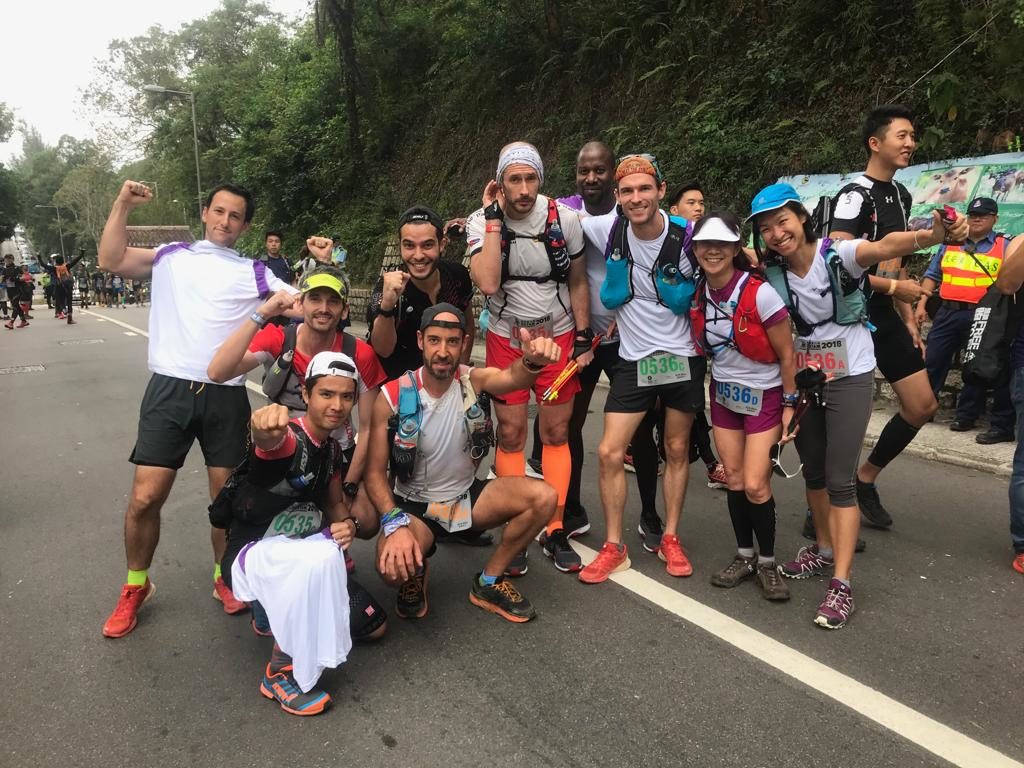
The beginning, as in every first hours of each race, was very smooth, good mood, good vibe, chatting and joking around, comparing the distances of our GPSs, talking about strava stats. After 4km, Clément’s watch was showing the double, after I told him we were not running as fast as El Guerrouj, he got upset because he had to reset his watch. I told him “but that’s ok right?” – “ no it’s not” he replied, my strava will show only 96, people will think that I DNFed” …
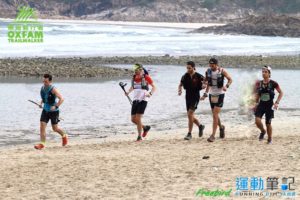 For the first 30~40km of the race I planned to stay behind at the last position in case one of our teammates would need help or anything and let the others lead the pace. Everything was nice and easy. Beautiful and scenic trails, already lots of stairs and somewhat pretty warm and humid. Benjamin, Sebastien and Guillaume were already soaked in sweat. We reached CP1 in less than two hours, we checked in, had a few drinks, a bit of food and in less then 10 minutes we took off. The path to CP2 was also smooth. We were still all very energetic and talkative. It is usually during these times that you hear people telling stories that they would only do when they are drunk. Benjamin revealed his trauma as a kid when he learned the dark story about Tonya Harding. .. making him doubt for a while about his sexual orientation… A good portion was on pavement. As a road runner, I hate to walk on concrete surface. My teammates chose to walk on hills regardless of the surface.
For the first 30~40km of the race I planned to stay behind at the last position in case one of our teammates would need help or anything and let the others lead the pace. Everything was nice and easy. Beautiful and scenic trails, already lots of stairs and somewhat pretty warm and humid. Benjamin, Sebastien and Guillaume were already soaked in sweat. We reached CP1 in less than two hours, we checked in, had a few drinks, a bit of food and in less then 10 minutes we took off. The path to CP2 was also smooth. We were still all very energetic and talkative. It is usually during these times that you hear people telling stories that they would only do when they are drunk. Benjamin revealed his trauma as a kid when he learned the dark story about Tonya Harding. .. making him doubt for a while about his sexual orientation… A good portion was on pavement. As a road runner, I hate to walk on concrete surface. My teammates chose to walk on hills regardless of the surface.
Moreover as a very bad walker, walking those hills made me even more tired so I ran the couple of kilometers left to the CP2, waiting for the rest of the crew to arrive and check in. I started to be hungry. We got some peanut butter and jam sandwiches. We spent about 15min there.
CP2 to CP3: “He always takes forever to take a dump “ Emile
Fatigue was starting to show its ugly face. We had been running for more than 4 hours, it was hot and a long and hard ascent was awaiting us. Benjamin took the lead with Sebastien. I was still at the back with Emile a few meters in front of me, he started to feel the fatigue setting in, the sweat dripping off our bodies were more and more pronounced. The jokes gradually faded and let the place to the loud sound of heavy breathing. After 30min of climb, Emile caught up with Sebastien despite slowing down himself, I was surprised. I had the impression that Sebastien was already in the red zone. I hoped I was wrong. As we were near the top, I took the lead and went ahead to give them some boost and motivation. Once on the top, one man was missing, Benjamin. He was supposed to be with Sebastien but as he fell back, we lost sight of him. As I was closing the path making sure nobody was behind me, I would have seen him if he stopped. Clément emitted the hypothesis of a Mother Nature call behind a bush, “or maybe he fell off a cliff and is now dead” he said.
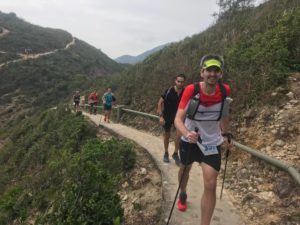
“Oh no, that would suck for the internal communication and marketing department, how can we make a Beyond2 movie if the guy is dead, let’s rule out this hypothesis”
Along the remaining way to CP3 we waited maybe about 15min, we started to be very worried. 15min is a very long dump. But Emile, trying to comfort us said “no it’s possible he’s behind, I know him well, he always takes forever to take a dump”. A loud silence followed. Once at CP3, Benjamin was there waiting for us, cool, he had been waiting for us for about 20 minutes. He was apparently chatting with a lady from another team and was so absorbed by the conversation that he never looked back and left us for dead. It is fascinating how a hormonal boost – most likely testosterone here – can trick the brain and act as a “natural” performance enhancer. Maybe the next-gen EPO … who knows.
We spent 16min at CP3 and had been running for 6 hours and 33Km. It was then 5pm. Guillaume who knows very well the section to CP4 told us it was going to be difficult, 13km and about two hours, half of which would be in the dark.
CP3 to CP4: Shiryu le chevalier du Dragon ( the dragon saint)
The main difference between an individual and team sport is the priority: when you belong to a team, the team always comes first. We all started having this engraved in our minds. We were battling not just for ourselves anymore but for the team and for all the people who made this possible.
The day before the race, I had a conversation with Benjamin who told me that one member of the team could DNF in case something happens, and finishing with 3 runners is still an option. Without explicitly saying it I felt he was referring to himself as if he felt his lag in the aerobic department would be a drag for the team.
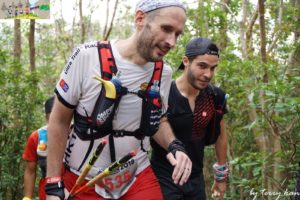
I was still playing my role of back door guardian. Not so long after we started the long ascent, Sebastien was a few meters in front of me, he seemed to be in pain and having difficulty to climb. He was leaning more and more forward, relying more and more on his hiking poles, his steps appeared heavier and heavier, I could hear him breathing louder. The distance between us and the rest of the team started to grow. I was hoping for a temporary low. As I was about to ask him if he was ok, he stopped and screamed “F***, I can’t move”. I then called the team to stop and to wait a bit. We were concerned about his state, we pretended everything was going to be ok, trying to make a few jokes but they no longer felt as funny. It was a hard moment, the hardest was probably for Sebastien, who had been in the leadership with Guillaume on this whole project encouraging and giving good advice to the team during the months leading to this event. After 3 long hours, we finally arrived at CP4. It was now 8pm, ran 46km over 9 hours. We were low in energy and needed to fuel.
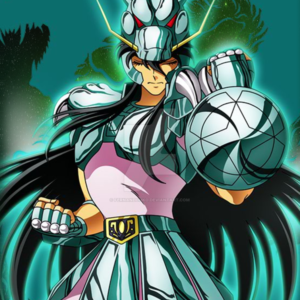
One of my favorite animes when I was a kid was “les Chevaliers du Zodiaque”, a bunch of mazochist warriors fighting the forces of evil to protect Athena and the innocent people etc. As opposed to lone heroes as in many classic animes at that time the Chevaliers was a team of 5 heroes, fighting together against the bad guys. One particular trait of this team was their will to sacrifice themselves for the sake of justice, love etc etc. beyond the cliches classic animes like to promote, the conveyed message was fairly simple, we’re all part of something bigger than ourselves, sacrificing oneself for the success of the team is what makes them individually heroes. One of them Shiryu the Dragon Chevalier was famous for giving up his sight to save his comrades. Although Sebastien didn’t gave up his sight (thank God) we felt like the spirit of Shiryu at CP4. After 28min we were en route to CP5 and to Shatin pass, where friends and family were waiting for us. Guillaume told them we would arrive at 8:30 PM. We were one hour late.
CP4 to CP5: la puissance du port du Havre, la culture de la bettrave
Leaving CP4 was hard, we left our teammate and we would never have thought this would have happened. The way to CP5 was on a downhill road towards Shatin pass. My wife and some colleagues were waiting
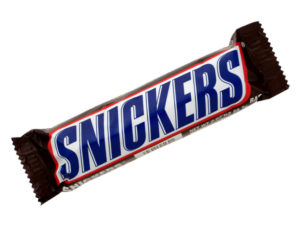
for us there. It was the little ray of light we were waiting for to lighten our path in this dark night. I was running at a good pace maybe around 4:30min/km or so since I was eager to see them. The night before I had entrusted Walid, the eleventh member of our team, with my second secret weapon, Snickers Bars aka “La puissance du port du Havre”. After a couple of kilometers down the hill, I could finally see them. The mental fatigue suddenly disappeared, the cold and foggy atmosphere became warm and clear again. We took some pictures, I exchanged a few hugs with the wifey and a few jokes with other friends and colleagues. Cyril, a colleague from the IT department was also there and ready to run with us for the next 30km, until CP8. Although I had been working and talking with Walid and Cyril over the past 5 years or so, I met them for the first time the day before. It was cool to see them suited up ready to go to the battlefield. Right before we were about to take off, I received my Snickers bars. It was so much than simple Snickers bars, way beyond plain junk food, those Snickers bars were the embedment of the support of the Natixis team. One bite provided me with the energy infused by the encouragement of dozens of people. It felt Goku eating a senzu bean (haricot magique).
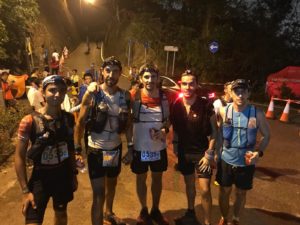
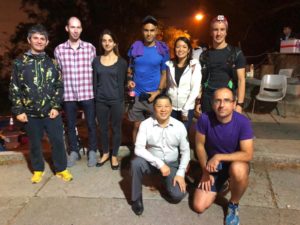
After only 10min of emotion we took off – now with two new and fresh teammates – to the battlefield mentally ready again to tackle the remaining mountains. We then reached CP5 after one hour or so. We had now been running for 54km and over 11 hours and 30minutes.
CP5 to CP6: “You wanna joke?”
That section was fairly smooth, only 6km, with 130m of ascent and 320m of descent, mostly trails that were more or less technical and as we still carried with us the mental boost we got from Shatin pass it went pretty quick. On top of it, Walid was on fire, the rate of jokes were coming out of his mouth at the speed of light. The dude is super trash, but it did make us laugh like idiots. He was running not far from me, and oftentimes I would hear “hey Harrisson, you’re ok?”, “yeah I’m good” I always replied. Then he goes “do you want a joke?”, “yeah spill it out”. Rinse and repeat for the entire section, about one hour or so. As I got fueled mostly by my snickers bars and by Walid’s and Clément’s jokes (who got inspired by the former to debit some profanities of his own). Emile also got a sudden energy boost. But it was not an endogenous production of testosterone like Benjamin did earlier but rather an exogenous metabolism of paracetamol, aka Panadol. He and other members of the team were jokingly talking about it since CP2 but the guy had been secretly ingested some pills since who know when. That… is not a joke
CP6 was where we were supposed to get udon noodles and other fancy stuff. As soon as we got there, Emile disappeared for a good 10min. After he came back we asked him what the heck he was doing. “Nothing” he replied. “Did you see the Udon noodles?”.. we asked. “yeah, forget about it, it’s too far, like up a big hill and 5km away, and there is nothing left, and it tastes like sh***”. Sure Emile…. sure. We stayed 15min and took off.
CP6 to CP7: when plastic tastes good
All my teammates seemed to agree that this was going to be the hardest part of the race, Needle hill, a mountain not so high but very steep. We had run so far 60km over 13 hours, it was around midnight, mentally and physically tired, even Walid had reduced the rate of his jokes. This section is 9km long, with 725m of elevation gain and 580 of elevation loss, all on technical terrain under very poor visibility. It was all but fun. The grind lasted around 2 hours and 15 minutes. For me the climb was not so bad, but the descent was very painful, my quads really started to hurt and as the path was narrow and crowded that made it even more painful. That section left us with some scars that would stick with us until the end. We were more and more like zombies, just putting one foot in front of the other. Benjamin was complaining about a sharp on-and-off pain on his right Achilles tendon since the last CP and it did not seem to get any better. It was still a long way to go before the finish line and we were all a bit concerned about it
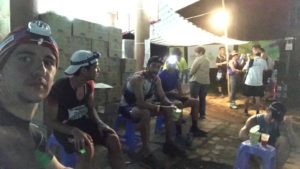
My mum used to tell me when I was a kid that at times of war, when you are starving, you would eat any kind of crap on your plate. I never eat instant noodles. Charles (in team 2) is a big fan but I find it taste like plastic. CP7 offered overcooked instant noodles soaked in water for too long. It tasted like plastic puree. Yet I swallowed an entire cup in less than minute. At that very moment I understood the deep meaning of my mum’s words.
CP7 to CP8: a man and his beer
Tai Mo Shan, the highest peak of Hong Kong was the next challenge. As most of the course was on the road, it was ok for me. I was happy to go back into running. Since the others were hiking/walking I got to the top before and waited for them. I sat on the ground, and looked around me. Nothing, only surrounded by a thick fog. Not a runner in sight. I heard a sudden noise, thinking it was our crew, but it was a monkey. He was standing still 3 meters in front of me. We stared at each other for a few seconds. I was thinking, “why am I doing all this s****, I could be in my bed”. The monkey turned around and showed me his butt, he looked at me again then he left. I was probably looking like s****, he was probably telling me to get lost. I then took my last snickers bar, la culture de la bettrave. After a short while, the guys caught up with me. We were about to start the descent. The visibility was extremely poor. I was running down almost blinded and was only following a white line on the ground. It was the only thing I could see for the next 5km. After 96 minutes we finally reached CP8. We had almost covered 80km and running for more than 17 hours. Cyril bailed out from there. He had run what he had planned to do. Then Emile came to us and said “I need a beer”. That was the last time we saw him. He called it a day, he really wanted his beer. Then I thought maybe Clement would also come up with a BS reason to bail out, but he didn’t. Although he was the least trained, the youngest of the team. Yet he stayed, and this despite an overdose of vaseline on his groin area. And just like that, we were down to 5 runners from 7.
CP8 to CP9: it’s not going to happen
With about 20k or so to go and 17h34min, I thought a sub 20 hours was still feasible. I tried to motivate my teammates and gave some power of “la puissance du port du Havre”. We were back on the road, my territory. I felt comfortable again and confident we could make it. I started to run again in the hope my comrades would follow me. Guillaume and Clement did, but Benjamin handicapped with his Achilles tendon could not follow. Walid was staying behind to support him. I then accelerated a bit, after a while I turned my head back to see if the two were following… they were not. I was again just by myself. After a few minutes though Walid caught up with me. We ran together until CP9. It was the last CP before the finish. Unfortunately, the clock was showing 18 hours and 50 minutes. I thought we had another 10km to go but Guillaume told us that in actuality, 12.5km was the right figure. Those extra 2.5km hit like a hammer on the skull, sub-20 hours…that was not going to happen. Walid was feeling sick because of the food. Guillaume went to lie down. Benjamin was complaining again about his Achilles tendon. My feet had several blisters and my quads were shot. We were all sleepy. Clement and I went ahead to try to get people back on their feet.
CP9 to the finish line: Vince Lombardi
The next 6km were flat on an undulating easy trail. After a few minutes, Guillaume rapidly got back on his feet and started to run again. We were a few minutes to the sunrise. I was happy to see him taking the lead again. Unfortunately, Benjamin could not follow, his tendon was in a bad shape and was forced to a walk. Guillaume, then switched back to a fast walk. Clement continued a bit ahead of him. I tried to walk behind Guillaume but it was impossible. One step of his equals one and half steps of mine, I was forced into a walk / run pattern in order to follow him. After 2km or so, I got tired to switch back and forth and went back into running. I took the lead again, hoping Benjamin and the others would follow. After a while we hit the last climb of the course, about 200m climb on the road. I waited for them at the top. We ran back down, this time on stairs again… Then the final 4km were on the road. I took the lead again and ran to the gate of the finish area, 700m away from the finish line. I sat there, waiting for them. I could not realize it was almost over. After about 5~10min, the rest of the crew finally came. It was hard to believe, but we were about to put an end on 21 hours of fun, laughter, sweat, pain, agony…. those 700m seemed long and short at the same time. The finish line was in sight, right in front of us. We ran slowly towards it, then walked accross that line we were seaking for 21 hours and 6 minutes. One thing for sure, we gave our best out there.
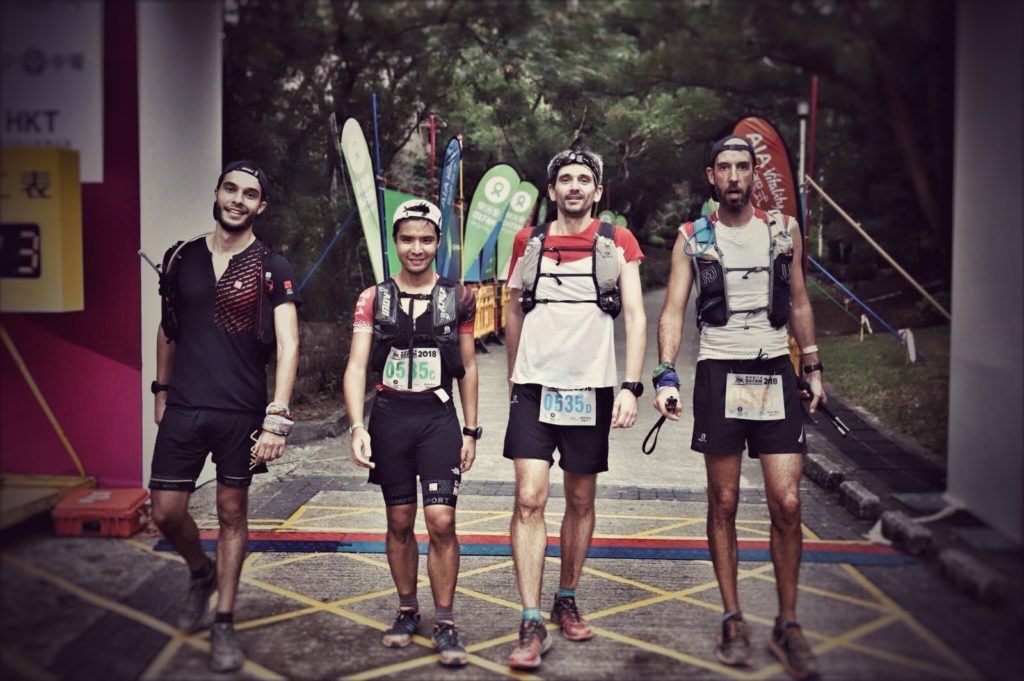
As we sat down and chatted a bit, Guillaume’s voice was missing. He was after all the reason we were all here. He was simply lied down, like the rest of us, exhausted. I looked at him and thought about a quote that holds an important place in my life:
I firmly believe that any man’s finest hour, the greatest fulfillment of all that he holds dear, is that moment when he has worked his heart out in a good cause and lies exhausted on the field of battle – victorious. Vince Lombardi
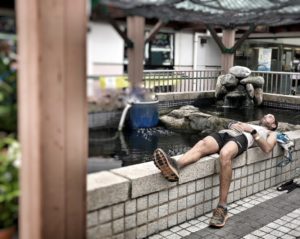

“I then took my last snickers bar, la culture de la bettrave. ” Not sure if there’s some missing references about beetroot…? :Or
It’s as if the text got cut in that section.
Haha, it’s not an accidental cut, that was a reference to a stupid french song, a recurring joke during the race